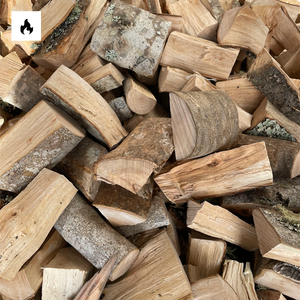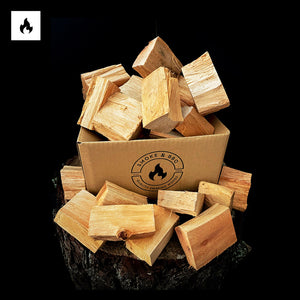FAQ’s When Smoking Meat On The BBQ
The concept of smoking meat at a low temperature and waiting for it to cook seems simple. The information is accurate when you are a beginner, but since there is so much conflicting information floating around, there are many details you'll have questions about. So without further ado, let's get started with some of the most frequently asked questions about smoking meat with your bbq smoker at home.
What type of wood should I use?
There's no correct answer here. Most types of woods can be used, as long as it's not pine, cedar, spruce, sycamore, redwood, or fir, as these contain resin and oil. If the wood is treated with chemicals, stay away from it.
Several versatile kinds of wood work well with a wide variety of meats, like cherry, pecan, and oak. It is also important to be aware that wood types can be combined to your heart's content, and blends of different types of wood are available for purchase.
Use our flavour profile chart here as a guide. The meat you cook has a higher level of robustness, so can the wood. Fruitwood goes well with all types of meat, poultry, fish, and game (beef, lamb, and pork). It is mild. It is best to use Manuka and Oakwood to cook beef, although they can be toned down when combined with wood on the lighter side of the flavour profile to cook other meats.
Is it a good idea to soak wood chunks or chips?
There's a lot of debate about this! Experiment with this on your own if you want to learn more about it. You should soak your wood for one smoke, then let it air dry the next time you use it. You won't notice much difference in your meal either way, but you might decide you prefer one over the other. I think it makes more sense to soak chips than chunks since they tend to burn much faster.
Is it necessary to wrap my Brisket In foil or butcher paper?
Wrapping is also a matter of personal preference. It is vital to wrap your Brisket halfway through a 12-hour cook because it will already be smoked heavily. As soon as you have a nice bark, you might as well wrap it up to prevent moisture loss.
With butcher paper, you're going to give the Brisket a little breathing room, while foil will create a tight seal. Although foil can produce a more juicy brisket, it may reduce the amount of flavour in your meat.
How do I maintain my BBQ smoker?
Cleaning your smoker depends on how frequently you use it. Before cleaning the inside of the unit, make sure all coals have been extinguished. Rinse thoroughly and let air dry before using again. Wipe out the interior of the unit with a cloth or paper towels. When you have finished cooking and the unit has cooled sufficiently, clean out the ashes. Ashes can collect moisture and rust prematurely. After the fire has cooled, clean out the ash and coals from the firebox with a brush, and dispose of the debris according to the guidelines set by your local garbage company.
The inside of your smoker can develop rust. By regularly coating the interior surfaces with vegetable oil, you can help keep your unit protected. Additionally, the exterior paint will need to be touched up from time to time. We recommend using a commercially available black high-temperature spray paint. Do not paint the interior of your BBQ smoker - a big no-no.
Do I need to add sauce, and when?
While some regions serve their meat without sauce, it's perfectly fine to use sauce when grilling. Nevertheless, you should not add the sauce too early. Typically, that means waiting until your meat is about 15-30 minutes from being done. As a result, the sauce will stick nicely to the meat without becoming too rigid or smokey.
When smoking meat, should I wear gloves?
Many pitmasters wear black gloves at BBQ events and instructional smoking videos on YouTube. The gloves are nitrile powder-free. To keep them from getting too hot, cotton gloves are sometimes worn underneath.
What kind of meat should I smoke first?
Ribs would be my first choice. It takes less than six hours to cook, and you can't go wrong with this recipe. In addition, ribs are relatively small and inexpensive, so you can cook for yourself and a few others before smoking something larger.
So go ahead and smoke whatever you've been craving. Despite any problems you encounter or inability to maintain the required temperature or a problem with your smoker, you can always finish off your meat in the oven. If you went out and purchased your first smoker because of that thick cut of Brisket, then, by all means, smoke away!
How often should I check my meat?
Not at all, unless you need to deal with the meat (wrap, add sauce, etc.). It's ideal if your smoker indicates the cooking temperature somewhere on the outside, and you can insert a probe into your meat if you're shooting for a specific temperature.
Cooking at 200-something degrees does not pose much of a risk of burning meat when you smoke it. It's not like an oven at 400 degrees, which makes sense to check periodically. You lose a lot of heat every time you open your smoker, so don't do it!
What is the difference between hot and cold smoking?
When you think of "smoking meat," you probably think about "hot smoking." Hot smoking both cooks and flavours the meat. Cold smoking only aims to add smoke flavour to the meat. In the 40-130 degree range, bacteria reproduce rapidly, making cold smoking dangerous. On the other hand, hot smoking is usually done at a minimum temperature of 200 degrees, so you won’t have a worry about botulism.
Conclusion
There are many different opinions out there when it comes to BBQ techniques, as you can probably tell from my responses above. There is no clear answer most of the time, so experiment and see what works best for you and your pallet. Once you've mastered your desired smoking meat abilities, we would love to see them. Tag us in your next social media post @smokeandbbqnz
f I missed any questions you'd like answered - or if you have any opinions of your own - feel free to leave them in the comments below or pop us an email. We are always on the hunt for additional tips, tricks, advice and ideas you may want to share with us.
Happy Smoking, Folks!
The Team at Smoke & BBQ








